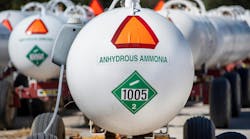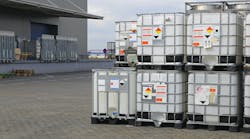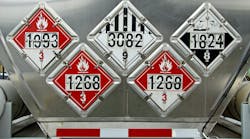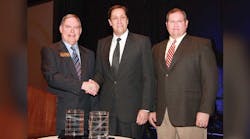Companies subject to the formal Maintenance Startup and Shutdown (MSS) permitting program, like the one Texas has implemented, have a direct requirement to be estimating these emissions.
But even if the state has not gotten formal about it yet, there are few strong incentives for starting to do so, according to Rob Ferry, a partner at the TGB Partnership. He addressed the implication of the Environmental Protection Agency-based program during the 2012 International Operating Conference organized by the International Liquid Terminals Association and held May 21-23 in Houston, Texas.
“If you start accounting for it, you'll be ready when your state catches up,” he said. “In addition, you're already covered from the viewpoint that you hopefully won't have to get the state's new permit program, which will have all sorts of owners' special conditions, because you are already authorized in your existing permit. But to do that, you had to have estimated.
“Second, the state can't view yours as new emissions because you've been accounting for them all along.”
Added Larry Darcey, vice-president of Sage Environmental Consulting LP: “Even if your state or jurisdiction says it's OK, that may not withstand a legal challenge. In some cases, the facility and state have found themselves as co-defendants when an NGO (non government organization) files suit over a permit. Complicity on the part of the regulatory agency in neglecting certain sources of emissions does not make it legal.”
There are two classes of MSS activities:
- Planned, or scheduled, which are routine and predictable activities.
- Unplanned, or unscheduled. This is a startup or shutdown that was not part of normal or routine facility operations, is unpredictable as to timing, and is not the type of event normally authorized by permit; or a maintenance activity that arises from sudden and unforeseeable events beyond the control of the operator that requires the immediate corrective action to minimize or avoid an upset or malfunction. Unplanned/unscheduled MSS activities and emissions cannot be permitted or authorized.
It includes tank cleaning; floating-roof tank landings; vessel clearing, degassing, and cleaning; equipment repair and/or replacement; painting, sandblasting, and surface preparation; portable tanks; and vacuum trucks.
“What we found in Texas is that best available control technology (BACT) may require additional equipment, higher operational and maintenance costs, and additional planning,” Darcey said. “Health Effects Modeling and NAAQS demonstrations can be challenging given the relatively high emission rates during MSS and the stack/dispersion characteristics of temporary control devices and fugitive releases. Modeling proposed flexibility requires iterative analyses.
“Permitting of MSS may be viewed as all ‘new’ emissions unless represented in historical emission inventories or source/activity can be demonstrated to be grandfathered.”
Ferry said that a 2009 TCEQ workshop on MSS permits reviewed multiple sources of emissions:
- Floating-roof landings.
“They occur when emptying floating-roof tanks. Landing a floating roof on its support legs opens the vacuum breaker vent and creates a vapor space under the floating roof. The space under the landed floating roof then behaves like a fixed-roof tank.
“The vapor space under the landed floating roof is vented to the head space above the deck. This head space is vented to the atmosphere. Two modes of emissions occur: standing idle losses while the roof remains landed and refilling losses when the tank is refilled.
“Emissions occur while the tank stands idle after landing the floating roof. Modeling these emissions depends upon liquid heel versus drain dry condition. If drained dry, available liquid is limited to clingage: IFRT (internal floating roof tank) versus EFRT (external floating roof tank). The vapor space under a landed IFR will behave in a manner similar to a fixed roof tank, but an EFR will additionally have wind effects.
“Refilling expels vapors from under the deck. The quantity of vapors residing under the deck prior to refilling depends upon the standing idle condition. Incoming liquid generates additional vapors. Thus, even a completely vapor-free tank will have vapors in the air displaced from under the deck.”
He said landing-loss estimation methods are published in API Technical Report 2567.
- Vacuum truck emissions.
“There are three types of vacuum truck operations: vacuum pulled in the vacuum truck tank, pump turned off, vacuum in the truck tank then pulls material into the truck tank; positive displacement pump is used to move material into the vacuum truck tank; air mover is used to move material into the vacuum truck tank.
“Option A has the potential to emit one truck tank volume of emissions while the vacuum is being pulled, but none while drawing material into the truck tank. If cleaned beforehand, there are no emissions. Options B and C emit continually while material is being drawn into the truck tank.
“The TCEQ 2009 workshop stipulates that if you're using a positive displacement pump, estimate emissions as one times the loading loss equation. If you're using air blowers, estimate emissions as two times the loading loss equation. For Option A, when the truck tank was not previously cleaned, use the volume of the truck tank with the loading loss equation. The TCEQ example uses a temperature of 95 F. The TCEQ 2009 workshop does not separately address short-term (lb/hr) emissions for vacuum trucks. Perhaps the use of 95 F is intended for the short-term calculation.”
- Frac tank.
“The TCEQ 2009 workshop stipulates that you estimate emissions as for a fixed-roof tank. MSS emissions are due to ‘clearing’ process vessels and lines. Steps involving MSS emissions: draining liquid to temporary storage; and opening/degassing the vessel or line.
“For draining a process vessel or line, if the receiving storage container or vessel is temporary, estimate emissions using the loading loss equation. Use ‘proper’ values for the parameters. If the receiving storage container or vessel is permanent and already authorized to receive liquids of this type, then emissions from such container/vessel are not MSS emissions.
- Opening a process vessel or line.
“The TCEQ 2009 workshop stipulates two sources of emissions to be accounted for: vapors remaining in the vessel or line; and evaporation of liquid from the wetted walls of the vessel or line, which is clingage.
“For vapors remaining, the TCEQ 2009 workshop stipulates: Use the Ideal Gas Law, which is what the loading loss equation is derived from; assume the vapor space to be saturated; use the volume of the vessel; and use the total vessel pressure. Note that this assumes that the gas drawn into the vessel during emptying is entirely hydrocarbon vapors, with no air.”
- Vapors from clingage in a process vessel or line.
“The TCEQ 2009 workshop stipulates that you assume a layer of material 0.0004 inches thick, multiply by the vessel surface area to get the volume, and multiply by liquid density to get mass. Neglect trivial contributions: If the TVP is less than or equal to 0.1 psia, neglect vapor space emissions. If the TVP is greater than 0.1 psia, neglect clingage emissions.
“The TCEQ 2009 workshop does not stipulate a procedure for short-term emissions, but advises: Consider different scenarios to determine ‘realistic worst case.’”
- Speciating emissions from clearing a process vessel or line.
“The TCEQ 2009 workshop does not stipulate a procedure for speciating these emissions, but typical, or best, practice for floating-roof tanks is: Use the vapor-phase speciation profile for vapors that occur from partial evaporation of a liquid bulk — appropriate for the initial volume of vapors that escape when opening the vessel. Use the liquid-phase profile for the subsequent evaporation of clingage, on the assumption that all of the liquid evaporates.”
- Surface-coating emissions.
“The TCEQ 2009 workshop stipulates: Use mass balance to estimate VOC emissions, assuming that 100% of VOC content in the applied paint evaporates upon application. Use additional factors to estimate PM emissions, as specified in the TCEQ presentation.”
Sources not listed in TCEQ 2009 MSS workshop:
- Opening of miscellaneous small vessels (e.g., meter proving, filter change-out).
“It's similar to clearing process vessels. Account for loss of a vessel-volume of vapors and evaporation of clingage on the inside surfaces of the vessel. Assume a clingage layer of 0.0004 inches.”
- Pig retrieval.
“Evaluate as for filters and meter provers. Account for one volume of vapors released, plus account for evaporation of clingage. Include the surface area of the pig in the clingage calculation.”
- Pole float retrieval from a slotted guidepole.
“There is no ‘opening of a vessel,’ but there is clingage on the surface of the float. There is also an uncontrolled slotted guidepole while the float is removed. Account for uncontrolled emissions from the slotted guidepole for the time the float is removed, and evaporation of clingage from the float.” ♦









